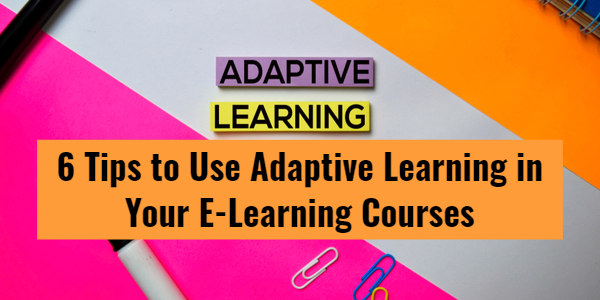6 Tips to Use Adaptive Learning in Your E-Learning Courses
In the final blog of this three-part series, we have tips to help you integrate adaptive learning in your organisation. Adaptive learning is all about creating personalised experiences for learners to improve engagement and training outcomes.
In previous blogs, we looked at when and how to use adaptive learning in your e-learning training programme, and the benefits of doing so.
What about the practicalities of using adaptive learning? It might sound challenging, but a professional e-learning developer will be able to implement adaptive learning to your e-learning and training strategy. The following tips will help.
-
Create a Continuous Learning Culture
Adaptive learning is about empowering learners as it often has a strong element of self-directed learning. Therefore, it is helpful to have an established continuous learning culture in your organisation. At all levels of your company, employees and executives should constantly seek ways they can develop new skills and knowledge, while also improving existing skills.
-
Decide If Adaptive Learning is the Right Strategy
Adaptive learning is not right for all training topics or situations. In our previous blog, we outlined some of the situations where a linear approach to e-learning course creation is more suitable. This includes situations where everyone needs to receive the same information or where you need to distribute the training as soon as possible.
Therefore, the first step you should take in relation to adaptive learning is to decide if it is the right approach or not.
-
Decide on the Right Adaptive Learning Strategy
There are lots of different ways you can personalise e-learning content, so there are several techniques you can use to implement adaptive learning. The most common include:
- Create separate linear paths – a common example of this method is to separate the content based on job role or location. For example, you could create an e-learning course with one path for staff in the UAE and another for staff in Saudi Arabia. You then ask learners at the start of the course which option is more relevant to them. The content within each path doesn’t have to be completely unique. Instead, focus on the elements where personalisation will offer the greatest benefits.
- Create a single e-learning course with a pre-training assessment – this is an algorithmic approach where you create a course with various modules. Learners then complete a pre-training assessment that determines which modules they receive.
- Create an adaptive learning scenario – scenarios are one of the most powerful adaptive learning tools you can offer. Even straightforward scenarios enhance engagement and help with the learning process. Adding an adaptive learning element takes it to another level. With an adaptive learning scenario, additional information and training materials are presented to learners within the scenario if they make an incorrect choice. If they make the right choice, the detailed information is not shown in full. This allows people who are familiar with the topic to progress through the scenario quickly, while those that need further coaching get the information they need.
- Use just-in-time training – just-in-time training is a strategy that can be used for adaptive learning. With just-in-time training, you create a library of courses that learners complete when they need them most. If the learner is already familiar with some of the topics, they don’t need to go through the training. Instead, they can focus on areas of weakness. This is adaptive learning in action.
- Add easy skip functionality – this method of adaptive learning involves creating an e-learning course in modules. You then give learners the opportunity to skip modules if they are already familiar with the topic area. This allows learners to adapt the training to their needs as they progress through it.
- Add advanced accessibility features – another common motivation for implementing adaptive learning into your training strategy is where accessibility is a high priority. In other words, adding features that personalise the course according to the accessibility requirements of the learner.
-
Focus on Highly Relevant Content
The whole purpose of adaptive learning is to create personalised and highly engaging learning experiences, so make sure you make the content as relevant as possible. This particularly applies to stories, examples, and scenarios.
-
Make E-Learning Courses Modular
Modular e-learning courses are much easier to improve and keep up to date, as you don’t need to update the entire course if you want to make a small change. Instead, you can update the relevant module only. The modular approach also makes it easier to implement an adaptive learning strategy, as you can create modules that are the same for everyone as well as those that are customised for different groups of people.
-
Review Analytics and Feedback
Reviewing e-learning analytics, reading feedback, and assessing the impact of your training course/s are important for all training activities, including adaptive learning. By reviewing the performance of your course/s, you can identify areas that can be improved, as well as sections that can be further personalised.
The Importance of Personalisation
Using an adaptive learning approach is more difficult than creating standard linear e-learning courses. However, it’s important to remember the people who will be completing your training are increasingly familiar with receiving personalised experiences when they engage with online content and platforms.
It is also important to keep your training objectives in mind, focusing on return on investment. By following the tips above and having an effective training strategy, you can achieve better returns by personalising the learner experience through adaptive learning.
